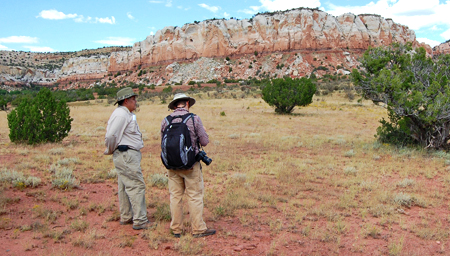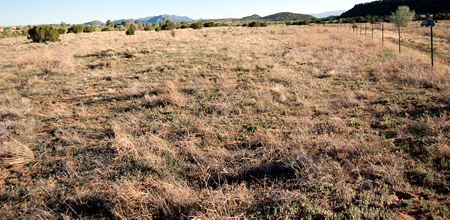
Tribal Representatives

A representative of the Pueblo of Tesuque confers with Parametrix ethnographer Shawn Kelley at Pueblo Colorado during preparation of the Galisteo Basin ethnographic study.
The sites in the Galisteo Basin and the Santa Fe River drainage were created and used by Native Americans, European Colonizers, and American ranchers. Input from descendant populations is a critical part of the Galisteo Basin Archaeological Sites Protection Act. The best known and largest archaeological sites in the Basin were established by Pueblo peoples. Representatives of a number of modern day Pueblos have participated in the GBASPA committee and working group, and continue to advise the BLM. Tribal advice relates to past uses of the sites and current sacred sites. Although the current culture often refers to sites as “abandoned” that view is contrary to that of modern Native American communities, for whom the locations as alive and inhabited by the spirits of their ancestors.
As expressed by a tribal representative:
|
"We still have connections to these sites. Just because we no longer live there doesn’t mean they are not still important to us. We need to be thinking of creative ways to help demonstrate to the lawmakers, land managers, and general public how Native Americans see the world. The world is not bounded and separated." |
As part of the planning process for the GBASPA included preparation of an Ethnographic Study in which background information about tribal connections to the Basin through time was assembled, and visits to sites with tribal representatives to collect their recommendations for site protection with a view to preserving access for religious observances and protection of features important to Native groups.
The Ethnographic Study prepared by the Parametrix Company in Albuquerque for the BLM includes the following summary statements:
The ethnographic field sessions provided an important setting to elicit Native American interpretations of the Galisteo Basin’s archaeological sites and landscape features. The sessions also helped lay the foundation for collaborative management between Native Americans and landowners/managers, especially in regard to the GBASPA sites. By providing the opportunity for tribal representatives to visit, assess, and comment on culturally significance places, the field-based interviews generated Native American management recommendations that are critical to better understanding and protecting the region’s cultural and natural heritage (Kelley and O’Meara, 2011:4-5).
The ethnographic study supports the following findings:
|
“1. Although Kewa (Santo Domingo) Pueblo represents the only remaining permanent Native American settlement in the basin, a number of other Pueblo, Apache, Comanche and other tribes maintain oral histories and strong attachments related to sites and landscape features in the Galisteo Basin. These cultural attachments are demonstrated through their continued visitation to places in the basin for important religious and cultural activities,including pilgrimages and natural resource collection trips. Oral histories about places in and around the Galisteo Basin are maintained and passed on to younger generations by multiple Native Americans groups. “2. Given the cultural centrality of the basin, Native American communities experience numerous and significant social impacts when development occurs in the region. This includes any type of development, ranging from residential subdivisions to natural resource exploration and exploitation. Therefore, concerns for future development were voiced universally among tribes that participated in this study as well as by Pueblo leadership at the All Indian Pueblo Council and the Eight Northern Indian Pueblos Council. “3. The Native American groups that participated in this study, hold traditional knowledge and practices that can inform the protection and management of sites and landscape features in the basin. As a result, Native American groups are willing and enthusiastic to form partnerships with government agencies, land managers, and private property owners to manage and monitor the Galisteo Basin’s cultural resources. “4. To ensure long-term cultural heritage preservation for both current and future generations, it is critical for Native American groups to have access to sites in the Galisteo Basin, to perform traditional cultural practices, and to obtain collection rights to gather traditionally important natural resources” (Kelley and O’Meara, 2011:4-2 to 4-3). “Throughout the ethnographic study, tribal representatives reiterated that Native American epistemological understandings of sites and landscape features are seen as culturally interconnected. Thus, although specific sites in the Galisteo Basin have their own associated and distinctive oral history, their use and cultural significance are interrelated to places both within and outside of the geographical boundaries of the basin. In the future, tribes would like to see this perspective reflected in more holistic management plans and practices. A cultural landscape inventory and nomination of the basin would aid in facilitating development of such plans/practices” (Kelley and O’Meara, 2011:4-11). |
Tribal involvement in planning and protection of Galisteo sites is ongoing and active.

© New Mexico Office of Archaeological Studies, a division of the New Mexico Department of Cultural Affairs.
The Center for New Mexico Archaeology
7 Old Cochiti Road
Santa Fe, NM 87507
505-476-4404
Fax: 505-476-4448

